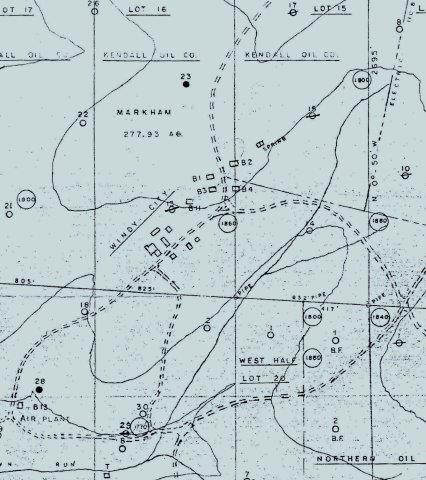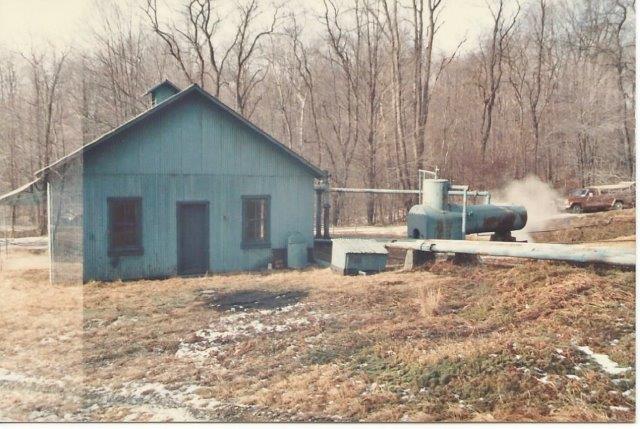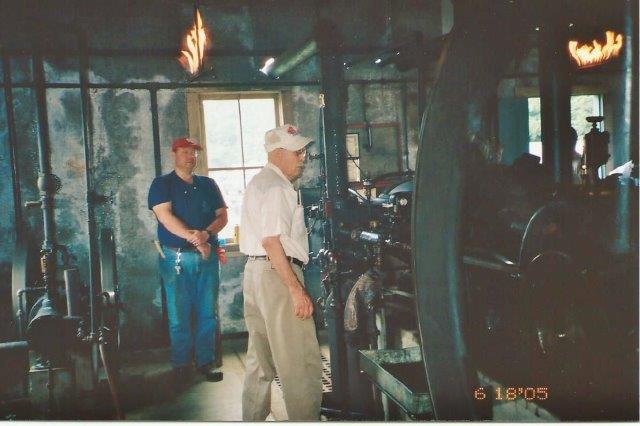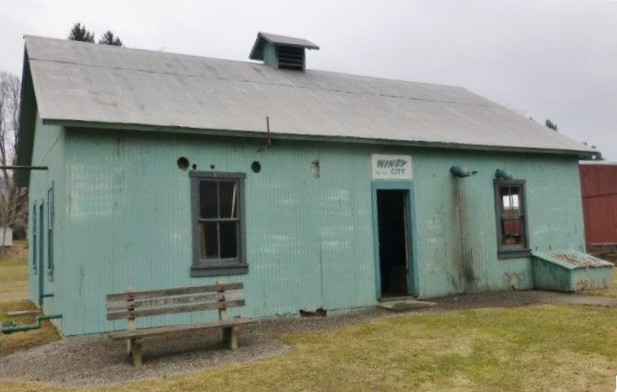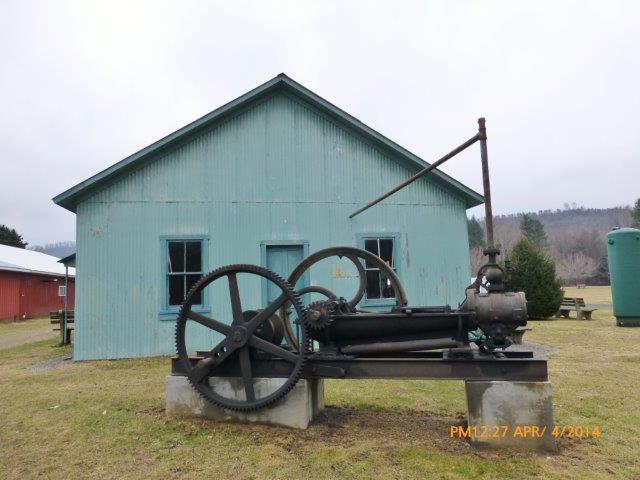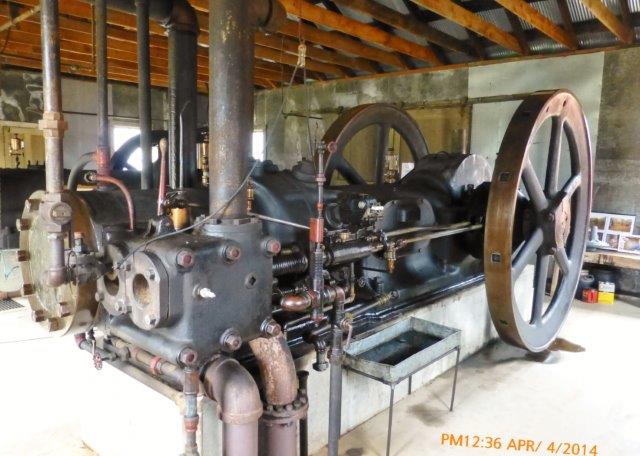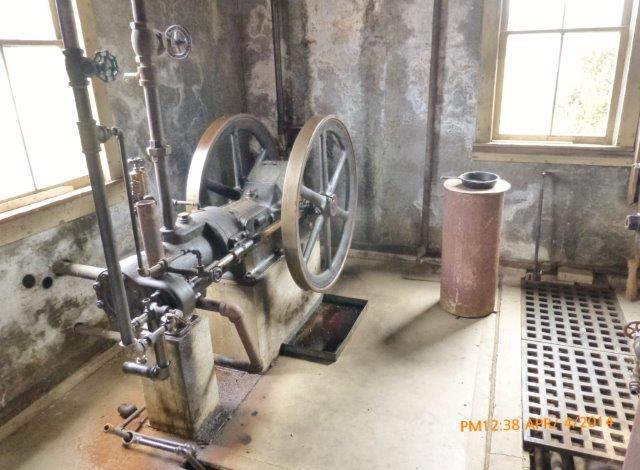|

May 2014
Windy City
By
Paul Harvey
Nestled deep in the Allegheny
National Forest was a little community named
Windy City.
Don't bother to find it now for it no longer exists. Southwest of Kane,
Pennsylvania, and through the town of James City, one finds a lonely
forest service road that leads on a few miles to an open, grassy site
with a space big enough to turn around, as shown in Photo 1.
My last visit to the site was in 2009 and the wind seemed to whine
in the pines, recalling much happier days. Alone with the ghosts of days
gone by, I could again see the few houses and buildings and hear the
loud exhaust of the Blaisdell engines from the air plant echoing across
the valley floor. This is Windy
City and this is its story.
I first stumbled upon Windy
City in the late 1960s while driving some
desolate back roads in search of old engines. Suddenly I found myself
in a forest of ancient steam engines, each rigged to pump an oil well.
At one stop I could definitely hear the bark of large gas engines,
so I
headed in that direction. Driving on for about two miles, I came upon a
green building, standing open, with two large Blaisdell combination gas
engine-air compressor units in full operation. I had never seen such a
sight! After wandering around a bit, I was greeted by Harold "Jim"
McCauley who was station operator, well pumper, and maintenance crew all
rolled into one. Jim was the sole resident of the town and the total
work force that kept the lease pumping for Kendall Refining of Bradford,
Pennsylvania. Photo 2 is a 1972 topographical map that
shows the buildings of the community as well as the air plant location.
Over the years Jim and I became very good friends, and he explained much
of the history and technology to me. He taught me how to operate the
Blaisdells and how to know when an oil well was "pumped off." He
thought that Windy
City was probably born in the 1880s when the
oil wells were drilled with the steam engines that still pumped them.
The community was always small and focused on the oil and timber
industries. The lease, consisting of 44 oil wells, was known as "The
Griffith" and was operated by Kendall. As the
wells gradually declined and the boilers deteriorated, a new method of
pumping was needed. In 1916, an air plant containing the two Blaisdell
engine-air compressors was erected to provide compressed air to operate
the steam engines, replacing the aged boilers. This proved very
successful and many other plants were erected in the neighboring areas.
Only four wells were still in operation on the plant's final day of
operation, July 12, 1989.
One lazy afternoon, I asked Jim why he had chosen to stay at
Windy City.
He just replied, "It's a good life." He continued to explain that he
loved to hunt, so during the autumn and winter he could take his gun
with him, get the plant running and some wells pumping, then hunt
for a
couple of hours to get some fresh meat for supper. During his later
years there, he bought "Big Red," a four wheeler, to save walking to all
the well sites. Loving to keep the well sites and station area well
mowed, he always carried his faithful scythe on Big Red, stopping to
trim a bit here and there. His scythe, which he pronounced as "sigh,"
still hangs in our Windy
City air plant exactly where he kept it.
Photo 3 shows the museum's Blaisdell, still on location
and operating, in the early 1980s. The Blaisdell engines were
manufactured in Bradford,
Pennsylvania, and the firm still exists today
making Zippo lighters! One engine could pump two oil wells and both
engines together could pump five wells. Perhaps not very efficient but
definitely better than the individual boilers. Sometimes, if Jim was
not in town when I visited, I would just make myself at home (I knew
where he kept the key) and start this engine to relax a couple of hours
in his rocking chair, falling asleep to the rhythm of the exhaust and
the motion of the engine. I would then replenish the starting air, wipe
everything clean, drain and shut off the water, and leave without a
trace. At least I thought I left without a trace! Later, Jim
told me that he was aware of my visits!
The Windy City
air plant in operation is illustrated in Photo 4. Note
the old boiler to the right which served as the first air receiver and
the long pipes laying near the ground which allowed the air to cool and
the moisture to condense before being distributed to the steam engines on
the wells. The plume of steam behind the boiler was rising from the
water cooled engine exhaust which belched out over a small stream.
The compressed air, maintained at 80 psi, operated the individual steam
engines as shown in Photo 5. The gear reduction was known
as the "cog wheel" and operated the walking beam at 24 strokes per
minute. Crude oil produced from each well gravitated to a large tank in
the valley where it would be transported by truck to the refinery.
When the Windy
City air plant finally closed its doors in
the summer of 1989, Coolspring
Power Museum
acquired the complete building, its contents, and one of the Blaisdell
engines. During its final few years of operation,
Windy City
had been under Pennzoil management. The structure was dismantled and
all the interior pipe work, parts, and equipment were photographed so
that assembly would be an exact duplication of the original. With
everything moved to the museum, the project of installation and
reassembly began. Two changes were made as the project unfolded. First,
we decided to widen the building five feet to accommodate our visitors'
safety by providing more observation space. Second, since we had only one
of the Blaisdells, we decided to add our Flickinger gas engine-air
compressor, removed from a similar air plant in
Bradford, Pennsylvania, to
replace the other Blaisdell. Both changes proved to work well.
During the Museum's 2005 June show, we had a delightful visit
from Jim, his last to see his beloved air plant as reconstructed at
CPM. The Blaisdell was running and the gas lights were lit as Jay, our
engineer, chatted with Jim. Jay then asked Jim if he could still start
the engine, and proceeded to stop it. Jim just said, "Course I can!" and
proceeded to go through the entire procedure and had it running much
easier than we ever did. See Photo 6. He then proceeded
to instruct us on some fine points of operation to ease the starting
procedure which we have used ever since. He passed away the
following winter at the age of 90 or so.
Photo 7 depicts the front view of our re-erected
Windy City
air plant as seen a few weeks ago. It has been in operation for over
ten years now, and the exhaust report of the Blaisdell can still be
heard over two miles away. Photo 8 shows one
of the original steam engines, a 12 hp Farrar & Trefts, made in
Buffalo, New York.
We installed it next to the Windy City air plant in 2013. It
again operates on compressed air, and we plan to include the walking beam
and well head to the display this year.
Our Blaisdell gas engine-air compressor unit is shown in Photo 9.
These units are massive with seven foot diameter flywheels and
weighing twelve tons. It is rated at 65 horsepower with an operating
speed of 180 rpm. The same cylinder is used for both the engine and the
compressor, having a bore of 16 inches and a stroke of 20 inches. The
head end of the cylinder is the gas engine, which has a side mounted
valve chest containing the power operated intake and exhaust valves.
This is easily seen in the photo. Engine speed is controlled by a small
pendulum governor carried on the intake valve pushrod. In event of
over-speed, the pendulum fails to open a small fuel valve. The rear end
of the cylinder toward the flywheels is the air compressor. Sealing
this on the piston rod is a "stuffing box," or packing gland, so the rod
can end in a sliding cross head. The intake to the compressor is
accomplished by a rotary "corliss" valve that is power operated.
Compressor discharge uses pressure actuated poppet valves. It is a
magnificent machine to see in motion!
As supplied from the factory, Blaisdell provided a diminutive version to
provide starting air for the larger machine. The unit, noted in
Photo 10, was intended only to run when needed to replenish the
starting air tank. Having a five inch bore and six inch stroke, it
operates at 400 rpm. Interestingly, it does not have timing gears but
employs an unusual "wig-wag" cam to impart four-cycle operation. Note,
to the right of the starting engine, the vertical piece of well casing
pipe with a lid and skillet on top. Having a gas burner inside, this is
one of the devices that Jim used to heat the building as well as to cook
his lunch. It is exactly as he left it.
The museum tried to duplicate exactly the lay-out of the air plant as it
appeared in its days of operation. Photo 11 shows the
interior, just beside the big Blaisdell, as it appears today. Jim
loved to sit in his rocking chair while eating fried bologna sandwiches
cooked on the heating stove. The work bench has his vise and all the
spare parts and pipe fittings. One can see the spare piston and rod
stored under the bench. Looking at Photo 12, one will
travel back to the late 1970s and view a remarkably similar scene. Note
the favorite rocking chair, the work bench, the vise, all the parts
including the piston underneath. History has been preserved for all to
appreciate.
Photo 13 shows the 50 horsepower Flickinger gas engine-air
compressor that we installed in our Windy
City display. Like the Blaisdell, it was
also built in Bradford,
Pennsylvania, and served a similar purpose
within the city limits of Bradford. Its home was
on West Washington Street
where it pumped a small group of oil wells with compressed air. The
overall principal is the same as the Blaisdell's, but it features
several interesting design differences. Most noticeable is the side
shaft and vertical governor head. Having some significant problems, it
is finally going back together and will be running in the near future.
Flickinger also supplied small gas engine-air compressor units for
filling the starting air receiver tank. These were the most
attractive, and probably the most serviceable, of the several small
engine-compressor units manufactured in Bradford.
Photo 14 shows the one we have added to our display to
compliment the big Flickinger. These little units were marketed for
many applications where compressed air was needed. Beside the engine is
a vertical air storage tank capable of being filled by either of our
starting engine-compressors and storing enough air to provide several
"starts" of the big Blaisdell. A monkey wrench hanging on the
small pipe leading to the pressure gauge is difficult to see in the
photo.
Jim used it to securely turn off the air tank so the pressure would not
leak away, and we continue to do the same.
For additional photos of both air plants as well as
patent drawings of the engines, please see our website,
coolspringpowermuseum.org. On the home page, click on the "Exhibits"
tab then scroll down to Windy
City. Click on "Tour"
for a detailed trip to the air plant, both in the days gone by as well
as today. You will have a great tour.
After the Windy
City air plant officially ceased production
of crude oil, the museum did a video of a special operation. On
July 12, 1989, Jim hosted a museum and filming crew, starting
the Blaisdell and operating a steam engine. He dictated an
excellent documentary of all his thoughts and actions, and this was
recorded. "Windy
City Air Lease...Its Last Run," a 45 minute DVD that relives the
by-gone days of Windy City, can be purchased at the museum gift shop.
Visit
Coolspring Power
Museum during any of its events to see
Windy City in
operation. Our volunteer engineer will be happy to chat with you and
explain the details. For a complete list of museum functions, please
see our website: coolspringpowermuseum.org or call 814-849-6883.
See you then!
|


